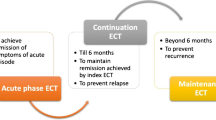Abstract
In electroconvulsive therapy (ECT), a dose titration method (DTM) was suggested to be more individualized and therefore more accurate than formula-based dosing methods. A repeated DTM (every sixth session and dose adjustment accordingly) was compared to an age-based method (ABM) regarding treatment characteristics, clinical outcome, and cognitive functioning after ECT. Thirty-nine unipolar depressed patients dosed using repeated DTM and 40 matched patients treated with ABM were compared. Montgomery-Åsberg Depression Rating Scale (MADRS) and Mini-Mental State Examination (MMSE) were assessed at baseline and at the end of the index course, as well as the total number of ECT sessions. Both groups were similar regarding age, sex, psychotic features, mean baseline MADRS, and median baseline MMSE. At the end of the index course, the two methods showed equal outcome (mean end MADRS, 11.6 ± 8.3 in DTM and 9.5 ± 7.6 in ABM (P = 0.26); median end MMSE, 28 (25–29) and 28 (25–29.8), respectively (P = 0.81). However, the median number of all ECT sessions differed 16 (11–22) in DTM versus 12 (10–14.8) in ABM; P = 0.02]. Using regression analysis, dosing method and age were independently associated with the total number of ECT sessions, with less sessions needed in ABM (P = 0.02) and in older patients (P = 0.001). In this comparative cohort study, ABM and DTM showed equal outcome for depression and cognition. However, the median ECT course duration in repeated DTM appeared longer. Additionally, higher age was associated with shorter ECT courses regardless of the dosing method. Further prospective studies are needed to confirm these findings.
Similar content being viewed by others
References
Krystal AD, Coffey CE, Weiner RD et al (1998) Changes in seizure threshold over the course of electroconvulsive therapy affect therapeutic response and are detected by ictal EEG ratings. J Neuropsychiatry Clin Neurosci 10:178–186
Sackeim HA, Prudic J, Devanand DP et al (2000) A prospective, randomized double-blind comparison of bilateral and right unilateral electroconvulsive therapy at different stimulus intensities. Arch Gen Psychiatry 57:425–434
Sackheim HA, Prudic J, Devanand DP et al (1993) Effects of stimulus intensity and electrode placement on the efficacy and cognitive effects of electroconvulsive therapy. N Engl J Med 328:839–846
McCall WV, Reboussin DM, Weiner RD et al (2000) Titrated moderately suprathreshold vs fixed high-dose right unilateral electroconvulsive therapy; acute antidepressant and cognitive effects. Arch Gen Psychiatry 57:438–444
Chung KF (2006) Determinants of seizure threshold of electroconvulsive therapy in Chinese. J ECT 22:100–102
Abrams R (2002) Stimulus titration and ECT dosing. J ECT 18:3–9
Kellner CH (2001) Towards the modal ECT treatment. J ECT 17:1–2
Petrides G, Braga RJ, Fink M et al (2009) Seizure threshold in a large sample; implications for stimulus dosing strategies in bilateral electroconvulsive therapy. J ECT 25:232–237
Boylan LS, Haskett RF, Mulsant BH et al (2000) Determinants of seizure threshold in ECT: benzodiazepine use, anesthetic dosage, and other factors. J ECT 16:3–18
Van Waarde JA, Van Oudheusden LJB, Verwey B et al (2012) Clinical predictors of seizure threshold in electroconvulsive therapy: a prospective study. Eur Arch Psychiatry Clin Neurosci 263:167–175
Van Waarde JA, Van Oudheusden LJB, Tonino BAR et al (2013) MRI characteristics predicting seizure threshold in patients undergoing electroconvulsive therapy: a prospective study. Brain Stimul 6:607–614
Fink M, Petrides G, Kellner C et al (2008) Change in seizure threshold during electroconvulsive therapy. J ECT 24:114–116
Coffey CE, Lucke J, Weiner RD et al (1995) Seizure threshold in electroconvulsive therapy (ECT) II. The anticonvulsant effect of ECT. Biol Psychiatry 37:777–788
Plakiotis C, Chin LF, O’Connor DW (2010) The change in electrical energy delivered to aged patients over a course of moderate dose unilateral electroconvulsive therapy. Psychogeriatrics 10:187–190
McCall WV, Reid S, Ford M (1994) Electrocardiographic and cardiovascular effects of subconvulsive stimulation during titrated right unilateral ECT. J ECT 10:25–33
American Psychiatric Association (1994) Diagnostic and statistical manual of mental disorders. American Psychiatric Association, Washington
Van den Broek WW, Birkenhäger TK, Boer D et al (2010) Guideline electroconvulsive therapy [richtlijn elektroconvulsietherapie]. Utrecht, de Tijdstroom
Montgomery SA, Åsberg M (1979) A new depression scale designed to be sensitive to change. Br J Psychiatry 134:382–389
Folstein MF, Folstein SE, McHugh PR (1975) “Mini-mental state”. A practical method for grading the cognitive state of patients for the clinician. J Psychiatr Res 12:189–198
Kellner H, Knapp R, Husain MM et al (2010) Bifrontal, bitemporal and right unilateral electrode placement in ECT; randomised trial. Br J Psychiatry 196:226–234
Pagnin D, de Queiroz V, Pini S (2004) Efficacy of ECT in depression: a meta-analytic review. J ECT 20:13–20
Chung KF, Wong SJ (2001) Stimulus dose titration for electroconvulsive therapy. Psychiatry Clin Neurosci 55:105–110
Petrides G, Fink M (1996) The ‘half-age’ stimulation strategy for ECT dosing. Convuls Ther 12:138–146
Damm J, Eser D, Schüle C et al (2010) Influence of age on effectiveness and tolerability of electroconvulsive therapy. J ECT 26:282–288
O’Connor MK, Knapp R, Husain M et al (2001) The influence of age on the response of major depression to electroconvulsive therapy, A CORE Report. Am J Geriatr Psychiatry 9:382–390
Tew JD, Mulsant BH, Haskett RF et al (1999) Acute efficacy of ECT in the treatment of major depression in the old-old. Am J Psychiatry 156:1865–1870
Rhebergen D, Huisman A, Bouckaert F et al (2015) Older age is associated with rapid remission of depression after electroconvulsive therapy: a latent class growth analysis. Am J Geriatr Psychiatry 23(3):274–282
Conflict of interest
None.
Author information
Authors and Affiliations
Corresponding author
Rights and permissions
About this article
Cite this article
Aten, J.J., Oudega, M., van Exel, E. et al. Repeated dose titration versus age-based method in electroconvulsive therapy: a pilot study. Eur Arch Psychiatry Clin Neurosci 265, 351–356 (2015). https://doi.org/10.1007/s00406-015-0591-3
Received:
Accepted:
Published:
Issue Date:
DOI: https://doi.org/10.1007/s00406-015-0591-3



